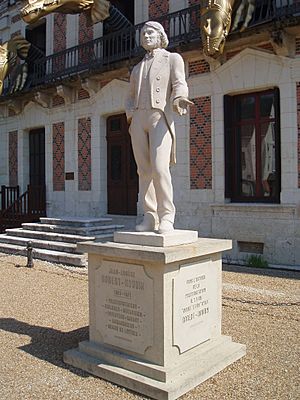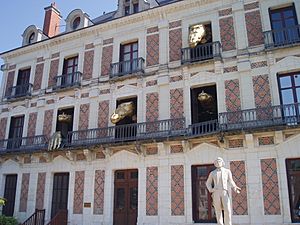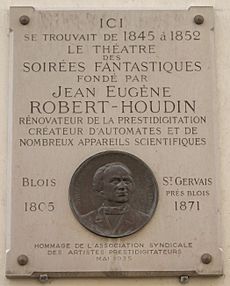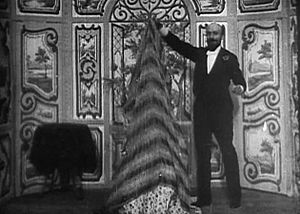Jean-Eugène Robert-Houdin facts for kids
Quick facts for kids
Jean-Eugène Robert-Houdin
|
|
|---|---|
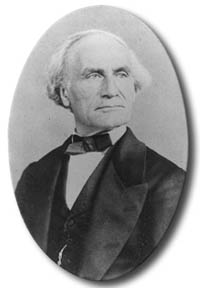 |
|
| Born |
Jean-Eugène Robert
7 December 1805 Blois, France
|
| Died | 13 June 1871 (aged 65) Saint-Gervais-la-Forêt, France
|
| Occupation | Magician, illusionist, inventor, author, and clockmaker |
| Spouse(s) | Josèphe Cecile Houdin (1830–1843; her death) François Marguerite Olympe Braconnier (1844–1871; his death) |
Jean-Eugène Robert-Houdin (born December 7, 1805 – died June 13, 1871) was a famous French watchmaker and magician. Many people call him the "father of modern magic." He changed magic from simple tricks seen at fairs to a fancy show for wealthy people. He even opened his own theater in Paris. Modern magicians often wear formal clothes, like Robert-Houdin did.
Contents
Early Life and Becoming a Magician
Jean-Eugène Robert was born in Blois, France. His father, Prosper Robert, was a watchmaker. Jean-Eugène's mother died when he was very young. At age eleven, he went to school in Orléans. When he was 18, he came back home. His father wanted him to be a lawyer, but Jean-Eugène wanted to be a watchmaker.
Learning to Be a Watchmaker
Jean-Eugène got a job as a clerk in a lawyer's office. But he spent his time playing with mechanical toys instead of studying law. His boss sent him back to his father, saying he was better suited for watchmaking. Since his father had retired, Jean-Eugène became an apprentice to his cousin, who owned a watch shop. He worked as a watchmaker for a while.
In the 1820s, he saved money to buy books about clockmaking. These books were called Traité de l'horlogerie. He continued to work on clockmaking his whole life. He is famous for inventing the "mystery clock."
Discovering Magic
When he opened his new books, he found a surprise! Instead of clockmaking books, he had two books about magic called Scientific Amusements. He was curious and decided to keep them. From these books, he learned the basics of magic tricks. He practiced magic all the time.
He found it hard to learn from the books because they didn't explain things well. So, Robert-Houdin started taking lessons from a local amateur magician. This man, named Maous, was a foot doctor who also did magic at fairs. Maous taught him how to juggle to improve his hand skills. He also taught him the "cups and balls" trick. Maous told him that practice makes your hands very quick. Robert-Houdin practiced a lot.
Magic was his hobby, but he kept studying horology (the science of measuring time). When he felt ready, he moved to Tours. He opened a watchmaking business there and did magic on the side.
Much of what we know about Robert-Houdin comes from his own stories. He wrote them to entertain people, so it's sometimes hard to know what's exactly true.
Marriage and Moving to Paris
Robert-Houdin performed magic at parties in Europe and the United States. At one party, he met Josèphe Cecile Houdin. She was the daughter of a watchmaker in Paris. Jean-Eugène fell in love with her right away. They got married on July 8, 1830. After they married, he added her last name to his, becoming Robert-Houdin. They had eight children, but only three lived.
He moved to Paris and worked in his father-in-law's shop. His father-in-law, Jacques-François, made watches by hand. Jean-Eugène worked on mechanical toys and automatic figures. While working, he kept practicing magic. One day, he found a magic shop owned by Père Roujol. There, he met other magicians and talked about tricks. He also met Jules de Rovère, who created the word ""prestidigitation"" for quick hand tricks.
At Père Roujol's shop, Robert-Houdin learned how mechanical tricks worked. He also learned how to make them better. He built his own mechanical figures, like a singing bird and a tightrope dancer. His most famous one was a figure that could write and draw. He showed this figure to King Louis Philippe and later sold it to P. T. Barnum.
On October 19, 1843, Josèphe died at age thirty-two after being sick. He had three young children to care for, so he remarried in August to François Marguerite Olympe Braconnier. She was ten years younger and took care of the household.
Robert-Houdin loved watching big magic shows in Paris. He dreamed of opening his own theater. A friend, Count de l'Escalopier, hired him to perform at private parties.
He started building his own magic equipment instead of selling it. The money from his shop and inventions helped him try new tricks. He wanted a stage that looked as elegant as the fancy rooms where he performed. He also decided that a magician should wear formal evening clothes.
Opening the "Palais Royale" Theater
Count de l'Escalopier gave him money to make his dream real. Robert-Houdin rented rooms above the gardens of the Palais Royal. This place used to belong to Cardinal Richelieu. He hired workers to turn the old room into a theater. They painted it white with gold trim. They hung nice drapes and placed fancy candelabras. The stage furniture was in the style of Louis XV.
On July 3, 1845, Robert-Houdin opened his 200-seat Théâtre Robert-Houdin. He called his shows "Soirées fantastiques" (Fantastic Evenings). No critics wrote about his first show. In his own stories, Robert-Houdin said the show was a disaster. He had stage fright and talked too fast. He felt like he didn't know what he was doing. He believed a magician should practice a trick until it was perfect. This made him over-rehearse.
After the first show, he almost had a nervous breakdown. He closed the theater and wanted to give up. But a friend said his idea was silly. This made Robert-Houdin angry and gave him courage. He decided to keep going with his show. At first, the forty-year-old magician was not smooth on stage. But he soon gained confidence.
With each show, Robert-Houdin got better. People started to praise him. Newspapers like Le Charivari said his mechanical wonders and artistic magic were as good as other famous magicians. Still, not many people came to his small theater in the summer. He struggled to keep it open. To pay for things, he sold three houses he had inherited from his mother.
The next year, he added a new trick that became very popular. It was called Second Sight. This trick brought many people to his theater. Once there, they saw his other amazing creations. He also performed outside Paris, sometimes with other magicians. For example, he performed in Liège in 1846 with the Belgian magician Louis Courtois.
Famous Illusions
Robert-Houdin used his skills with machines, along with showmanship and humor, to create his illusions. He believed that every magic show should build from one trick to the next. One surprise should lead to an even bigger one. Some of his tricks became very famous. Here are a few of them.
Second Sight
When Robert-Houdin first opened his theater, not many people came. He knew he needed something amazing to attract an audience. So, he thought of a mind-reading act for two people. He made up a story about how his son, Émile, created a game that led to the trick.
He called the trick "Second Sight." Other magicians had used this name, but Robert-Houdin's trick was different. He would walk into the audience and touch items people held up. His son, Émile, who was blindfolded, would describe each item in detail. This trick was a sensation and brought crowds to his shows.
Later, Robert-Houdin changed the trick. Instead of asking his son what was in his hands, he just rang a bell. This surprised people who thought they knew his secret code. He would even put the bell aside and stay silent, and his son still described every object.
Robert-Houdin made the trick even harder. He put a glass of water in his son's hands, and Émile drank from it. He could even tell what liquids people in the audience were just thinking about. People still tried to trick Émile. They brought books in Greek or strange tools like a thread counter.
The Ethereal Suspension
During Robert-Houdin's time, everyone in Paris was talking about "ether." He used this excitement to create an illusion that seemed to use the strong-smelling liquid. He told the audience he found a new property of ether. He claimed that if a person breathed in this liquid, their body would become as light as a balloon for a few moments.
He then "proved" it. He placed three stools on a wooden bench. His youngest son, Eugène, stood on the middle stool. Robert-Houdin put two canes on the other stools under his son's arms.
He opened a small bottle of ether. The audience could smell it in the theater. He put the bottle under his son's nose, and Eugène went limp. In reality, the bottle was empty. The smell came from his other son, Émile, who poured real ether on a hot iron shovel backstage.
Robert-Houdin took away the stool from his son's feet, and Eugène just hung there. Then he took away one of the canes, so Eugène was hanging by only one arm. He carefully placed his son's head against his raised hand. This was amazing enough. What he did next was even more stunning. He lifted his son upright in a horizontal position using only his little finger. Then he let go, and his son stayed suspended in the air. He was balanced only by his right elbow, with no other support.
When it seemed the ether was wearing off, Robert-Houdin put his son back upright. When Eugène woke up, he seemed fine. Robert-Houdin built up the surprise for the audience until it "exploded." This trick caused people to send letters of protest. They thought he was putting his son's health in danger, even though the ether had nothing to do with the trick.
Robert-Houdin was not the first to do a levitation illusion. The first in Europe was Ching Lau Lauro in the 1830s. An Indian magician was also said to have done it before that, but sitting cross-legged.
The Marvelous Orange Tree
This trick was probably inspired by an Indian mango tree trick. In that trick, a performer would grow a tree from a seed to fruit. Robert-Houdin had an egg, a lemon, and an orange on a side table. He went into the audience and borrowed a lady's handkerchief. He rolled it into a ball. He rubbed the ball between his hands, and it got smaller and smaller until it disappeared. He said it passed into the egg on the table.
He carefully picked up the egg. The audience expected him to crack it open and show the handkerchief. Instead, he made the egg disappear too. He told the audience the egg went to the lemon. He did this again with the lemon and the orange. When the orange disappeared, only a fine powder was left. He put this powder into a silver bottle. He soaked the bottle with alcohol and set it on fire.
A small orange tree in a wooden box was brought out by an assistant. The audience saw that the tree had no flowers or fruit. The blue flame from the bottle was placed underneath it. The vapors made the leaves spread and orange blossoms appear. Robert-Houdin then waved his magic wand. The flowers disappeared, and oranges bloomed.
He picked the oranges from the tree and tossed them to the audience to show they were real. He did this until only one was left. He waved his wand again, and the orange split into four parts. Inside, there was a white material. Two clockwork butterflies appeared from behind the tree. The butterflies grabbed the white cloth and spread it open. It was the spectator's handkerchief!
The Marvelous Orange Tree trick was used in the story "Eisenheim the Illusionist" and the movie The Illusionist (2006).
Robert-Houdin's Portfolio
Robert-Houdin carried a large portfolio, like a case for papers or art. It was only about two inches thick, too thin to hold anything but pictures.
He set it on two thin stands with the spine facing the audience. He took out drawings from it, as expected. One picture showed a woman without a hat. Then, he pulled out two ladies' bonnets (hats) decorated with flowers, one for winter and one for summer. He lowered the flap for each item he produced. Then, he showed a picture of birds. After that, he produced four live turtle doves from the portfolio.
He showed a picture of two cooks fighting with pots. This was followed by three huge copper pots. One was full of beans, another had flames, and the third was full of boiling water. As a final surprise, he lifted the top flap of the portfolio and pulled out a large cage filled with birds.
He walked toward the audience with the square cage. They clapped, thinking the trick was over. "Nothing here now—neither anything, nor anybody," he said, knocking on the upright flap. For the grand finale, he closed the portfolio one last time and produced his young son from it!
The Light and Heavy Chest
Robert-Houdin invented many tricks for his theater. One of his most amazing was the "Light and Heavy Chest." He used the new discovery of electromagnetism (how electricity and magnets work together). Robert-Houdin brought out a small wooden box, about a foot wide. He said he found a way to protect it from thieves. He asked a spectator, usually a small child, to lift it. The child lifted it easily. Then, he asked an adult man from the audience to lift the same box. The adult man could not lift the box!
Copied Inventions
Robert-Houdin's inventions were copied by his trusted mechanic, Le Grand. Le Grand was arrested for making and selling duplicate illusions. Many of these copied tricks ended up with other magicians, like John Henry Anderson and Compars Herrmann. It's not known if Herrmann bought them directly from LeGrand, but he and others performed them, even knowing Robert-Houdin invented them.
Robert-Houdin on Tour
Robert-Houdin's small theater became a very popular place for magic fans. Even King Louis Philippe rented the room for a private show. After his success at the Royal Palace, the king decided to visit Robert-Houdin at the Palais Royal in 1847.
The next February, a revolution ended Louis-Philippe's rule. This also stopped show business. All Parisian theaters closed. Robert-Houdin closed his theater and went on tour. He toured Europe briefly, then went to Great Britain.
Robert-Houdin performed in London at the St. James Theatre. He found out that Compars Herrmann was already there. Herrmann was calling himself "the Premier Prestidigitateur of France" and using copied versions of Robert-Houdin's tricks. Despite this, Robert-Houdin was still very successful. In 1848, he performed for Queen Victoria. After three months in England, he went home. He reopened his theater and became a regular part of Paris. In 1850, he gave the Palais Royal to his brother-in-law, Hamilton. This allowed him to tour France for two years. Then he went to Germany and returned to England, where he performed for Queen Victoria a second time.
He did a short tour of France. Then, at age 48, he stopped performing in public. He gave the theater back to Hamilton, who continued to fill the small theater. After Robert-Houdin retired, he worked on his inventions with electricity and wrote books. His home, "Le Prieuré," was very advanced for its time.
Magic Mission to Algeria
In 1856, Louis-Napoleon asked Robert-Houdin to help calm down tribes in French Algeria. The French army wanted to keep order in this new region. They were worried about religious leaders called Marabouts. These Marabouts controlled their tribes with fake magic. They told their leaders to go against the French. Napoleon wanted Robert-Houdin to show that French magic was stronger.
The magic mission started with a show at the Bab Azoun Theatre in Algeria. He performed twice a week. He also gave special shows for the country's tribal chiefs. He used The Light and Heavy Chest trick. In Paris, he used it for comedy. But in Algeria, he played it seriously. Robert-Houdin invited the strongest tribesman on stage. He asked the man to pick up the wooden chest. The man lifted it easily. Then Robert-Houdin said he would take away his strength. He waved his wand and said: "Behold! Now you are weaker than a woman; try to lift the box." The man pulled on the handle, but the box would not move. He tried and tried. When he tried to rip it apart, he screamed in pain. Robert-Houdin had rigged the box to give an electric shock if someone tried to rip the handles off. The man let go, ran into the aisle, and ran screaming out of the theater.
After his shows, he gave a special presentation for several tribal chiefs. He was invited to the home of Bou-Allem, the head of a desert tribe. In the desert, Robert-Houdin was challenged to do a special trick. He agreed and invited one of the rebels to shoot at him with a marked bullet. Robert-Houdin caught the bullet between his teeth. Bou-Allem gave him a certificate praising his mysterious acts. Robert-Houdin returned to France, his mission completed.
Robert-Houdin said that his shows helped. He said that people were told his "miracles" were just skill and an art called prestidigitation, not sorcery. He said the Arabs accepted this, and he became friends with them. The French government rewarded him for helping to prevent any rebellion.
Retirement and Death
After his mission in Algeria, Robert-Houdin gave his last public performance in Marseille. Then he went back to his home in Saint-Gervais, near his hometown of Blois. There, he wrote his life story, Confidences d'un Prestidigitateur. He also wrote several books about magic. He lived happily in retirement for about fifteen years.
Then the Franco Prussian War began. His son Eugène was a captain in the army. On August 6, 1870, Robert-Houdin heard that his son was badly wounded at the Battle of Wörth. Meanwhile, soldiers captured Paris. Robert-Houdin hid his family in a cave near his home. He found the Russian soldiers rude, but the Polish soldiers were kinder.
Four days later, Robert-Houdin learned that his son had died from his wounds. The stress from this and the war made him sick. He got pneumonia. On June 13, 1871, he died from his illness at age 65.
Name
It is not correct to call Jean-Eugène Robert-Houdin simply "Houdin." His full last name was Robert-Houdin. His birth name was Jean-Eugène Robert. When he married Josèphe Cecile Houdin, he was allowed by the French government to use the hyphenated last name.
Legacy
His home in Blois is now a museum and theater called La Maison de la Magie Robert-Houdin. His grandson, Paul Robert-Houdin, first opened it in April 1966. It is the only public museum in Europe that combines magic collections with a place for live performances. Many of Robert-Houdin's magic devices, including his automatons and mystery clocks, are kept in David Copperfield's private museum.
In December 1852, the Theatre Robert-Houdin moved to a new location in Paris. Ownership passed from Hamilton to Cleverman, then to Robert-Houdin's son, Émile. Émile was too busy to perform, so he arranged for Pierre Edouard Brunnet to present the shows.
After Robert-Houdin's death, Émile's widow sold the theater to Georges Méliès in 1888. Méliès was a magician himself, but he is best known as one of the first great filmmakers. He later showed his first movies there. He accidentally discovered special effects like stop-motion and showed his creations at the Theatre Robert-Houdin. One of his famous films is A Trip to the Moon. In 1924, the theater building was torn down.
Robert-Houdin wrote his autobiography, The Memoirs of Robert-Houdin. His life and work are also mentioned in books by Robertson Davies, especially in the novel World of Wonders.
The magician and escape artist Harry Houdini (born Ehrich Weiss) was very impressed by Robert-Houdin. After reading his autobiography in 1890, Weiss took the stage name "Houdini" to honor him. He thought that adding an "i" to a name meant "like" in French. However, later in his career, Houdini lost his respect for Robert-Houdin. He believed Robert-Houdin took too much credit for other magicians' ideas. So, he wrote a book called The Unmasking of Robert-Houdin in 1908.
Robert-Houdin is often called "the father of modern magic." Before him, magicians performed in marketplaces for common people. But Robert-Houdin performed in theaters and at private parties for richer audiences. He also chose to wear formal clothes, like his wealthy audience. This has become a tradition for many modern magicians who wear tail-coats.
Many cities have streets named after him, including Blois, Bourges, Caen, and Paris in France.
Films and Television About Robert-Houdin
- 1896: Escamotage d'une dame chez Robert-Houdin ("Retraction of a Lady at the House of Robert-Houdin"), a film by Georges Méliès. This was one of the first films with special effects.
- 1995: Robert-Houdin une vie de magicien, a documentary film by Jean-Luc Muller.
- 2006: The Illusionist, a movie where the main character performs some of Robert-Houdin's famous tricks.
- 2011: Hugo, a movie that shows an automaton, recreates Robert-Houdin's illusions, and explains how he inspired Méliès.
- 2013: Mysteries at the Museum, a TV show on the Travel Channel. It featured the story of Robert-Houdin's mission in Algeria and showed the wooden chest.
See also
 In Spanish: Jean Eugène Robert-Houdin para niños
In Spanish: Jean Eugène Robert-Houdin para niños
- List of magic museums


